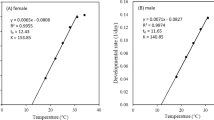Abstract
Ctenocephalides felis felis larvae were infected withDipylidium caninum at a range of temperatures from 20°–35°C at 3 mm Hg saturation deficit (SD) and 30°C at 8 mm Hg SD. Hosts were subsequently dissected at 6, 9 and 12 days after infection. Four replicate, experiments were performed and results of development, and host reactions analysed by the Genstat computer programme. These were found to depend on the temperature and saturation deficit of the environment. Unlike previous findings, parasite development and host reaction were found to be independent of host development. Host reaction was more marked and prolonged at 20°–25°C than at higher temperatures.
No perceptible growth of the parasite occurred at 20°C. The development patterns of growth at the higher temperatures were similar but shifted in time so that faster growth occurred at higher temperatures. Rate of growth was fastest at 35°C, despite the fact that this temperature was unfavourable to the hosts, all of which died at the time of pupation.
Similar content being viewed by others
References
Chen HT (1934) Reactions ofCtenocephalides felis toDipylidium caninum. Z Parasitenkd 6:603–637
Dunkley LC, Mettrick DF (1971). Factors affecting the susceptibility of the beetleTribolium confusum to infection byHymenolepis diminuta. JNY Entomol Soc 79:133–138
Edney EB (1945) Laboratory studies on the bionomics of the rat flea,Xenopsylla brasiliensis Baker andX. cheopis, Roths. I. Certain effects of light, temperature and humidity on the rate of development and on adult longevity. Bull Entomol Res 35:399–416
Edney EB (1947) Laboratory studies on the bionomics of the rat fleas,Xenopsylla brasiliensis, Baker andX. cheopis, Roths. II. Water relations during the cocoon period. Bull Entomol Res 38:263–280
Edney EB (1982) The truth about saturation deficiency — an historical perspective. J Exp Zool 222:205–214
Heyneman D (1958). Effect of temperature on rate of development and viability of the cestodeHymenolepis nana in its intermediate host. Exp Parasitol 7:374–382
Joseph SA (1974)Ctenocephalides felis orientis Jordan. 1925 as an intermediate host of the dog tapewormDipylidium caninum (Linn. 1758) Railliet, 1892. Cheiron 3(1):70–75
Lackie AM (1976) Evasion of the haemocytic defence reaction of certain insects by larvae ofHymenolepis diminuta (Cestoda). Parasitology 73:97–107
Lackie AM (1979) Cellular recognition of foreignness in two insect species, the American cockroach and the desert locust. Immunology 36:909–914
Lackie AM (1981) Immune recognition in insects. Dev Comp Immunol 5:191–204
Lackie J (1975) The host specificity ofMoniliformis dubius (Acanthocephala) a parasite of cockroaches. Int J Parasitol 5:301–307
Lie KJ, Heyneman D (1976) Studies on resistance in snails. 6. Escape ofEchinostoma lindoense sporozoites from encapsulation in the snail host and subsequent loss of the hosts' ability to resist infection by the same parasite. J Parasitol 62(2):298–302
Marshall AG (1967) The cat flea,Ctenocephalides felis felis (Bouché 1835) as an intermediate host for cestodes. Parasitology 57:419–430
Mellanby K (1933) The influence of temperature and humidity on the pupation ofXenopsylla cheopis. Bull Entomol Res 24:197–202
Mellanby K (1935) The evaporation of water from insects. Biol Rev 10:317–333
Salt G (1970) Experimental studies in insect parasitism. XV. The means of resistance of a parasitoid larva. Proc R Soc Lond (Biol.) 176(1043):105–114
Schiller EL (1959) Experimental studies on morphological variation in the cestode genusHymenolepis. I. Morphology and development of the cysticercoid ofH. nana, inTribolium confusum. Exp Parasitol 8:91–118
Silverman J, Rust MK, Reiron DA (1981) Influence of temperature and humidity on survival and development of the cat fleaCt. felis. J med Entomol 18(1):78–83
Solomon ME (1951) Control of humidity with potassium hydroxide, sulphuric acid or other solutions. Bull Entomol Res 42:543–554
Soltice GW, Arai HP, Scheinberg E (1971) Host-parasite interactions ofTribolium confusum andT. castaneum withHymenolepis diminuta. Can J Zool 49:265–275
Somme L (1966) The effect of temperature, anoxia or injection of various substances on haemolymph composition and supercooling in larvae ofAnagasta kuehniella (Zell). J Insect Physiol 12:1069–1083
Somme L (1967) The effect of temperature and anoxia on haemolymph composition and supercooling in three overwintering insects. J Insect Physiol 13:805–814
Sutcliffe DW (1962) The composition of haemolymph in aquatic insects. J Exp Biol 39:325–343
Sutcliffe DW (1963) The chemical composition of haemolymph in insects and some other arthropods in relation to their phylogeny. Comp Biochem Physiol 9:121–135
Taylor A (1935) Experimentally induced changes in the cell complex of the blood ofPeriplaneta americana (Blattidae: Orthoptera). Ann Ent Soc Am 28:135–145
Venard CE (1938) Morphology, bionomics and taxonomy of the cestodeDipylidium caninum. Ann NY Acad Sci 37:273–328
Voge M (1959) Sensitivity of developingHymenolepis diminuta larvae to high temperature stress. J Parasitol 45:175–181
Voge M (1961) Effect of high temperature stress on histogenesis in the cysticercoid ofHymenolepis diminuta (Cestoda: Cyclophyllidea). J Parasitol 47:189–195
Voge M, Turner JA (1956) The effect of different temperatures on the development ofHymenolepis diminuta inTribolium confusum. J Parasitol 42(Suppl.):31
Wyatt GR (1961) The biochemistry of insect haemolymph. Ann Rev Entomol 6:75–102
Yasuda F, Hashiguchi J, Nishikawa H, Wattanabe S (1968) Studies on the life history ofDipylidium caninum (Linnaeus, 1758). Bull Nippon Vet Zootech Coll 17:27–32
Zimmerman HR (1937) Life-history studies on cestodes of the genusDipylidium from the dog. Z Parasitenkd 9(6):717–729
Author information
Authors and Affiliations
Rights and permissions
About this article
Cite this article
Pugh, R.E., Moorhouse, D.E. Factors affecting the development ofDipylidium caninum inCtenocephalides felis felis (Bouché, 1835). Z. Parasitenkd. 71, 765–775 (1985). https://doi.org/10.1007/BF00926802
Accepted:
Issue Date:
DOI: https://doi.org/10.1007/BF00926802




